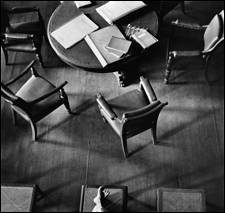
Dayanita Singh, Asiatic Library Reading Room, Bombay, 2000
|
Our furniture speaks volumes about us, not to mention holding our most intimate indentations. Pee-wee Herman had Chairry, a friendly talking chair; Whistler’s mother sat primly in a straight-back number; Archie and Edith Bunker’s sprung-spring icons, utterly central to their lives, are now in the Smithsonian. The great historic, cultural, and æsthetic importance of chairs is on the table, and on and off the walls, in "Chairs," which opens at the Isabella Stewart Gardner Museum on February 11 with a series of contemporary "Chair Portraits" by photographer Dayanita Singh and two related chair-based installations created by a multidisciplinary collaborative team comprising Singh, Italian furniture historian Fausto Calderai, designer Andrea Anastasio, art educator Carla Hartman, and filmmaker Michael Sheridan. First recognized for her photographs of India’s urban-middle and upper-class families, Dayanita Singh knows her way around elegant domestic surroundings. But she also has concentrated, in recent years, on "portraits" of places rather than people, photographs taken in a diverse range of interior spaces, often in her native India. In "Chairs," she shows black-and-white photographs of chairs from the Gardner’s collection and from all over the world, revealing unique personalities, social hierarchies, and complex relationships entirely through home furnishings. In the exhibition’s press material, she says she came to the Gardner in the summer of 2002 for the museum’s Artist-in-Residence program still carrying contact sheets of the empty spaces she’d been photographing in Calcutta in the weeks before. Once at the Gardner, she found herself drawn mainly to the museum’s collection of chairs — as though they were people she would have photographed for her earlier portraits. Singh’s "Chair Portraits" are on display in conjunction with a multimedia installation of her photographs projected onto an 18th-century Italian walnut chair from the Gardner’s collection. There’s also an upstairs installation of chairs from the collection arranged with an anthropomorphic eye to evoke dynamic social situations and individual personalities — leaving viewers to imagine the human activity that inspired the groupings, as if we’d happened upon the room, say, the day after a big party. Fast-forward from the salon to the locker room, the hardware store, and the bait shop and you’re in the macho territory examined by "Boys Life," which opens February 14 at the Evos Art Center in Lowell. Organized by Denise Markonish, director and curator of New Haven’s Artspace, where the show debuted last summer, "Boys Life" peers behind the clichés to discover what "boys will be boys’" might really mean — and how it applies to men — through the work of eight artists who in Markonish’s words "address stereotypically male-centered hobbies, and attractions, skewing the notion of what they mean to society by adding humor, social commentary, and art-historical references." A sense of boyishness prevails in work by Mark Andreas, Timothy Bailey, Stephan Jacobs, John Keefer, Andrew Mowbray, Samuel Rowlett, Huck Stoddard, and Joseph Wardwell as they explore topics from fishing to fixing and building to good old sex and rock and roll. These guys are no boy scouts — but "Boys Life" looks to blaze some new trails, or at least to head off the beaten track. "Chairs" is at the Isabella Stewart Gardner Museum, 280 the Fenway in Boston, February 11 through May 9. Artist Dayanita Singh speaks with Gardner curator Pieranna Cavalchini on February 12 at 1:30 p.m.; the program is free with museum admission. Call (617) 566-1401. "Boys Life" is at the Evos Art Center, 98 Middle Street in Lowell, February 14 through March 16; call (978) 441-9906.
|

